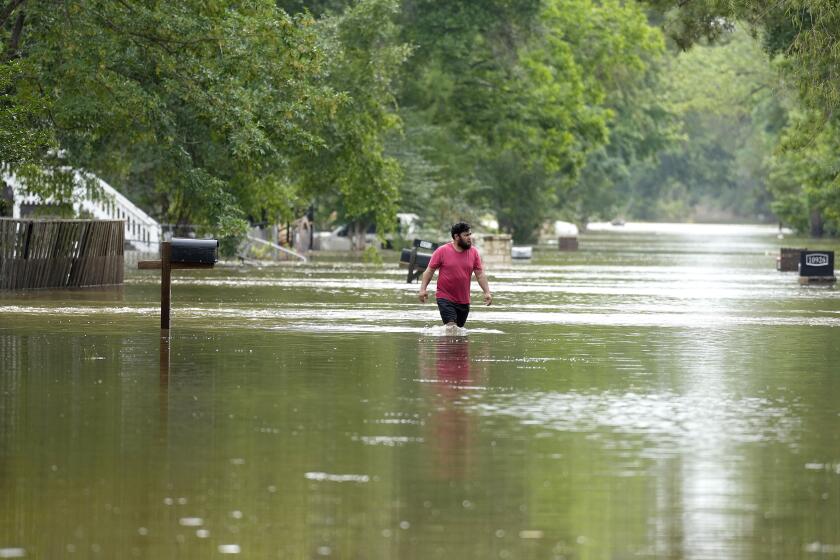Rosamond Carr, 94; Aided Young Rwandans Orphaned by Genocide
Rosamond Carr, an American expatriate who transformed her Rwandan flower shed into a refuge for children orphaned by genocide, died Sept. 29 at her home near Gisenyi in the mountains of northwest Rwanda. She was 94.
Her niece Ann Howard Halsey said the possible cause of death was pneumonia.
Carr had been living in Rwanda for more than four decades when, on April 6, 1994, a plane carrying the Rwandan president was shot down over the capital, Kigali.
The assassination set in motion the mass slaughter of ethnic Tutsis and moderate Hutus orchestrated by the Hutu-dominated government. More than 1 million people died before the killing came to an end.
Carr tried to protect her Tutsi neighbors from roving bands of Hutu killers. “They came round, these devils, about 20 of them. I’d known one of them all his life; he can’t have been more than 12,” she told the Times of London. “They were dancing up and down in the garden with spears. The people we were hiding ran, so at least I didn’t actually see anyone get killed. But I think they got all of them.”
She tried to stay, recalled David Rawson, U.S. ambassador to Rwanda at the time. “Belgian paratroopers knocked on her door and forcefully convinced her she ought to leave,” he said.
Back in the United States, Carr watched the appalling violence on television and determined that she had to help the orphaned and abandoned, about 300,000 in all.
After four months, she returned to her farm, and at the age of 82 converted a flower-drying shed into an orphanage for 40 children. She called it Imbabazi, meaning “a place where you will receive all the love and care a mother would give.”
She embodied that care, running the orphanage for the last dozen years of her life.
Carr was born Rosamond Halsey in 1912 in South Orange, N.J. The daughter of a Wall Street bond trader, she attended exclusive private schools before the Depression narrowed her options. After studying at the Traphagen School of Fashion in New York City, she became a New York fashion illustrator by day and a glamorous socialite by night.
Susan Southwick, who met Carr when Southwick’s husband was U.S. consular officer in Rwanda in the early 1970s, recalled that Carr’s beauty and sense of style never abandoned her, despite the hardships of living in rural Rwanda.
“She was a gracious, refined lady,” said Southwick’s husband, Michael. “Very friendly, very hospitable. She was like somebody from another era in that sense.”
She arrived in Africa in 1949 in the company of her husband of seven years, a dashing British explorer, filmmaker and big-game hunter named Kenneth Carr, who was 24 years her senior. Halsey, who helped her aunt tell her life story in the book “Land of a Thousand Hills: My Life in Rwanda” (1999), said the African adventure was a potential salve to their troubled marriage. “Most people would go to a marriage counselor; they went to Africa,” she said.
The Carrs sailed up the Congo River to what is now Kisangani and drove a secondhand pickup truck 620 miles to Gisenyi.
“We kept passing these little villages and little grass huts, and Kenneth said to me, ‘Are you going to be happy in one of those?’ and I thought, ‘Oh, how terrible,’ ” she told CBS News in 1999.
But it wasn’t terrible. Although her marriage foundered in 1955 -- the age difference and her desperate desire for children contributed to its demise -- her love affair with the country and its people never wavered. She bought a 270-acre flower plantation called Mugongo, moved into an ivy-covered stone cottage and planted a formal English garden.
On the plantation, a riotous palette of blue, red and yellow hydrangeas, lilies, alstroemerias, carnations, sweet peas and gladiolas -- 25 varieties in all -- thrived in the rich volcanic soil. She also grew and raised for export pyrethrum, a daisylike flower that produces a natural insecticide.
“The long road into her house was like a tunnel of blue hydrangeas,” Susan Southwick recalled. “Her gardens were absolutely beautiful.”
In 1967, Carr met another American woman living in Rwanda, the famed researcher Dian Fossey, who was studying the gorillas on the slopes of a nearby volcanic mountain.
Fossey was difficult, bossy and self-centered, Halsey said, but the two women were very close. Fossey died in 1985, presumably at the hand of poachers. In the movie of her life, “Gorillas in the Mist,” actress Julie Harris portrays Carr.
Even though her plantation went bankrupt numerous times over the years, Carr could not imagine leaving, despite the outbreaks of violence. In 1998, fighting began again, forcing Carr and the orphanage’s children to move to the lakeside town of Gisenyi.
They stayed until November, when they returned to the Mugongo flower plantation. About 120 children -- Hutus and Tutsis -- live at Imbabazi in a new complex that includes dormitories, a school and a kitchen.
Carr was buried on her farm near the orphanage. Survivors include a brother and a sister. Her former husband died in 1981.
More to Read
Start your day right
Sign up for Essential California for news, features and recommendations from the L.A. Times and beyond in your inbox six days a week.
You may occasionally receive promotional content from the Los Angeles Times.






